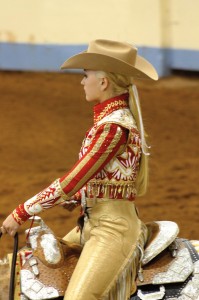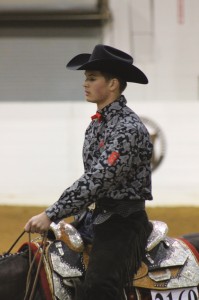Siblings Who Show
Click here to read the complete article
254 – October, 2014
By Lindsay Whelchel
In a rare moment of frustration, a young Claire McDowall was angry. She left the show ring and stomped back to her horse’s stall. The object of her wrath was her older brother Klay. He had just beaten her in a class, but that wasn’t why she was upset. Claire was mad, because in her young eyes, her brother should’ve let the other children in the ring have a shot at the win. “She was mad at him for winning so many classes and not giving the other little kids a chance, not her, but all the other little kids,” their father, Kelly McDowall, recalls fondly. “We had to explain to her about the meaning of competition, but we really didn’t want to discourage that behavior,” he says of his daughter’s concern for others.
Nowadays, the McDowall siblings don’t compete in the same age division, and regardless, there is rarely a fight. The pair has bonded over their shared love of showing horses, and that bond proves to be a common theme for other siblings who show side by side.
Whether it’s on the rail in the show ring or crammed into the same truck on the way to a horse show, siblings who compete together share a unique experience that sets them apart from their fellow equestrians. Considering all the possible challenges that can arise in the world of horse showing, having a sibling in the same boat is a huge benefit, according to the competitors we interviewed. A familial camaraderie endures in spite of potential logistical issues and whether one sibling is at the top or bottom of the judge’s score sheet.
When Klay McDowall took home a World Championship title in Horsemanship this year at the AQHA Youth World Show, Claire was the first person to greet him with a hug at the gate and offer her congratulations. The inverse is true when Claire does well. “When I placed at the Congress in Trail with my horse, when I walked out of the arena, he was right there with my family,” Claire says. At only 12 years old, she says she’s learning a lot from watching Klay, who is 16, succeed. “I’ve just learned from him by watching him, looking at what he does, and comparing it to others. That helps me get better,” she says.
Though this pair share the same last name and both enjoy running cross-country, showing horses, and competing in other sports, they admit their personalities are very different. Where Claire is outgoing, Klay is more reserved. “I’m very perky and sparky,” Claire says. “When somebody comes up to me, I’ve automatically made a new friend. He’s more laidback than me. I like being in the spotlight, and he likes being in the crowd; it kind of works.”
For Klay, being at a horse show means he must maintain his focus. It’s an environment that differs from home, because he actually tends to see less of his sister. They show in different groups and are active with their own friends and responsibilities. He credits his parents for dividing up their attention equally so neither sibling gets more time than the other. He says the arrangement has helped them stay very supportive of one another. Klay even admits it might be better if they still showed in the same age division. “We could look at how the others did certain aspects of the pattern or we could talk about the pattern with each other and how we’re going to want to do it.”
The Jordan sisters share that sentiment. For Lauren Jordan, she has enjoyed being able to watch her younger sister grow into the talented horsewoman she has become. “We got to compete together on two different horses, and it’s been fun for me to watch my little sister grow up,” Lauren says. “She was always a quiet little girl. She’s worked really hard. She’s gotten really fit, and she’s riding her horse all the time. It’s been really cool to watch her grow up and succeed. When it comes to competing against each other, they emphasize a team dynamic. “We’re really supportive of each other. We want each other to succeed, but we want ourselves to do good as well. It’s kind of a bittersweet mix of emotions. I really enjoyed it.”
Now, at the age of 19, Lauren is away at college. For her sister Lexi, 16, something is missing without her big sis in the ring. Though Lexi acknowledges the numerous supporters in her corner, she admits it’s sad that Lauren can’t be in the stands for every show. After all, it was Lauren’s involvement with horses that helped Lexi get her start. “I would go to the barn with her and watch her ride, and I saw how cool it was,” Lexi says. “I just wanted to do it so badly.” Lexi ended up joining in at the age of five and took riding lessons at the same jumping barn as Lauren. As they started to show together, the sisters could give each other pointers and encouragement in equal doses. There was also an advantage found in Lauren being able to take over Lexi’s green horse and help finish him out. After Lauren’s horse got sick, she took over Slater for a period of time.
“Slater was still kind of learning, and, at the time, Lexi was kind of submissive to the horses. If one of them was being naughty, she would let them get away with it. It worked out really well, in a way, that I could get on Slater and make him behave in the show ring,” Lauren explains. Lexi and Slater have since come a long way together with Lauren’s help at the beginning.
However, sharing horses isn’t something that always goes as planned. Lauren believes it works better when one sibling uses the horse for English classes and the other for Western. In the McDowall siblings’ case, Claire was able to borrow Klay’s horse to compete in Showmanship, but it wasn’t a class Klay competed in, so there was no confusion. Austin Green, who shows alongside his sister, Deanna, has seen situations arise where they have shared the same horse. “I know a couple of sibling teams who share a horse. For example, say a sister has a horse and the brother wants to get into showing, he would be a novice. I’ve heard of that happening,” Austin says. The Greens don’t currently share a horse, but they are familiar with the other side of the scenario. At the age of 15, Deanna has been showing for years, while, Austin, 19, just joined in on the fun last year.
However, they do travel together and haven’t had any real logistical concerns about planning their schedules for their respective classes or sharing the same trailer. When the siblings were younger, they used to fight a lot, Deanna admits. Now, she says they’re closer than the average brother and sister because of their common bond with horses.
“We’re really close. He’s my best friend,” Deanna says. “We’ve really learned that getting along with each other is a lot better. It’s helped our relationship a lot just being able to have something in common.” Austin echoes this feeling.
“It’s definitely made us a lot closer. I feel like we’re closer than a lot of my friends who don’t do horses,” he says. One of the many advantages that come with showing together is being familiar with the other’s horse and being able to help out with anything the other sibling might need. Now that they both compete against each other, there is a necessary balance that must be maintained with the competitive aspect of the sport. Thankfully, it involves a lot of humor.
“The good thing about it is we’re both really competitive,” Austin jokes. “It helps us to try to beat each other and helps us in the show ring, but the bad thing is that she usually wins,” Austin jokes. The competitiveness is endearing to Deanna, too. “My favorite moment was probably in February when we showed at the Sun Circuit. He beat me under one card, and he was really excited. He’s never let go of it,” she laughs. In all seriousness, both Deanna and Austin are there to support each other. “I’m always very happy when he does well, and he’s always the first one to congratulate me when I’m successful.” For all of these siblings, the importance of sportsmanship rings loud and clear, especially when it stays in the family.












